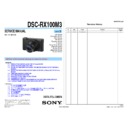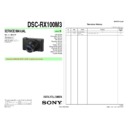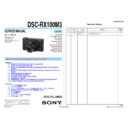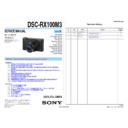Sony DSC-RX100M3 (serv.man2) Service Manual ▷ View online
DSC-RX100M3_L2
1-1
1. SERVICE NOTE
1-1. PRECAUTION ON REPLACING THE SY-1036 BOARD
DESTINATION DATA
When you replace to the repairing board, the written destination data of repairing board also might be changed to original setting.
Start the Adjust Manual in the Adjust Station and execute the “DESTINATION DATA WRITE”.
Start the Adjust Manual in the Adjust Station and execute the “DESTINATION DATA WRITE”.
RESTORE DATA
When you replace to the repairing board, get the data from the former one.
Start the Adjust Manual in the Adjust Station and perform “RESTORE DATA” to get the data.
The data getting for this model is as follows.
Start the Adjust Manual in the Adjust Station and perform “RESTORE DATA” to get the data.
The data getting for this model is as follows.
• PRODUCT ID & USB SERIAL No. INPUT
• Lens data carry
• AWB adj
• Light sensor adj
• Eye sensor adj
• EVF Data Input
• Lens data carry
• AWB adj
• Light sensor adj
• Eye sensor adj
• EVF Data Input
USB Serial No. and Product ID
The unit is shipped after an ID (USB Serial No.) unique to each unit and an ID (Product ID) unique to each model have been written.
These IDs have not been written in a new board for service, and therefore they must be entered after the board replacement.
After the board has been replaced with a board for service, start the Adjust Manual in the Adjust Station and execute the “PRODUCT ID & USB
SERIAL No. INPUT” and enter these IDs.
These IDs have not been written in a new board for service, and therefore they must be entered after the board replacement.
After the board has been replaced with a board for service, start the Adjust Manual in the Adjust Station and execute the “PRODUCT ID & USB
SERIAL No. INPUT” and enter these IDs.
Note: A newly entered Product ID is not always equal to the ID before board replacement. If the new ID differs from the previous ID, it may cause a difference from
the ID registered by the customer.
Update of MAC Address
When a board that contains Wi-Fi has been replaced or when replacing a board that contains the main IC (CPU), the IC’s unique number (MAC ad-
dress) must be reloaded.
Perform the following procedure to reload the IC’s unique number (MAC address).
dress) must be reloaded.
Perform the following procedure to reload the IC’s unique number (MAC address).
1. Download the latest-version Adjust Manual.
2. Install the downloaded Adjust Manual.
3. Start the Adjust Manual, and execute “Wireless LAN check” on the ADJUST tab.
4. Perform the following operations for the unit to initialize.
MENU
2. Install the downloaded Adjust Manual.
3. Start the Adjust Manual, and execute “Wireless LAN check” on the ADJUST tab.
4. Perform the following operations for the unit to initialize.
MENU
→ → [Reset Network Set.] → [OK] → ●
5. Perform the following operations for the unit to display MAC address.
MENU
MENU
→ → [Disp MAC Address] → ●
6. Confirm that the displayed MAC address has been updated.
Applicable parts
• SY-1036 BOARD, COMPLETE (SERVICE)
• SY-1036 BOARD, COMPLETE (SERVICE)
Note: The LOAD AND WRITE function in ADJUSTMENT DATA BACKUP on the DATA tab in the Adjust manual overwrites all data of the unit.
Therefore, the MAC address updated during the above procedure is also overwritten.
Perform the above operations after all work has been done.
After the replacement and repair, the MAC address is changed, and thus the re-setting for connection devices is required. Accordingly, download the
Flyer of WLAN Reset (Flyer of WLAN Reset_9834752[][].pdf) and print out it, and attach it to the set when returning the set to customer.
Flyer of WLAN Reset (Flyer of WLAN Reset_9834752[][].pdf) and print out it, and attach it to the set when returning the set to customer.
– ENGLISH –
Angular Velocity Sensor
When you replace to the repairing board, write down the sensitivity displayed on the angular velocity sensor (SE7701).
Start the Adjust Manual in the Adjust Station and execute the “Angular velocity sensor sensitivity ADJ”.
Start the Adjust Manual in the Adjust Station and execute the “Angular velocity sensor sensitivity ADJ”.
Type A:
Type B:
P Y
P Y
P: PITCH sensor sensitivity
Y: YAW sensor sensitivity
SY-1036 BOARD (SIDE A)
SE7701
Note: The sensor sensitivity of SE7701 of SY-1036 board is written only repair parts.
1-2. NOTES ON REPLACING THE LENS
When replacing the lens, read the QR code of the repair lens.
To read the QR code, start the Adjust manual and press the QR code reader button.
The read data is used in the following processes.
• Selection of Spacer Plate when mounting the imager board
• Adjustment after replacing the lens
To read the QR code, start the Adjust manual and press the QR code reader button.
The read data is used in the following processes.
• Selection of Spacer Plate when mounting the imager board
• Adjustment after replacing the lens
1-2-1.
Selection of Spacer Plate when Mounting the Imager Board
1. Load the Spacer Plate on the QR code reader screen.
2. The thickness of the Spacer Plate to be loaded is displayed.
2. The thickness of the Spacer Plate to be loaded is displayed.
3. Select the Spacer Plate according to the instructions on the screen and mount the imager board.
1-2-2.
Adjustment after Replacing the Lens
Perform LOAD from “Lens data carry” on the ADJUST tab in the Adjust manual.
QR code
DSC-RX100M3_L2
1-2
– ENGLISH –
1-3. NOTES ON REMOVING/INSTALLING THE IMAGER BOARD (CD-847 FLEXIBLE BOARD)
When the CD-847 Flexible Board (Imager) is mounted to the lens, shift and tilt adjustment is made with Spacer Plates.
When removing the CD-847 Flexible Board, pay attention to the following.
When removing the CD-847 Flexible Board, pay attention to the following.
(1) When the lens is not replaced
Example: In the case of disassembly, cleaning, or replacement of the CD-847 Flexible Board (Imager)
• Check and record the size of the built-in three Spacer Plates and store them so as not to lose them.
• When assembling the CD-847 Flexible Board, be sure to install the Spacer Plates to their original locations.
• When assembling the CD-847 Flexible Board, be sure to install the Spacer Plates to their original locations.
Size
0.xx
Note
Be careful not to lose the Spacer Plates.
If any Spacer Plate is lost or their previous positions are not sure, repeatedly take a photo and check that there is no local defocus.
Be careful not to lose the Spacer Plates.
If any Spacer Plate is lost or their previous positions are not sure, repeatedly take a photo and check that there is no local defocus.
Selecting appropriate Spacer
Plates
is needed.
(2) When the lens is replaced
Refer to “1-2. NOTES ON REPLACING THE LENS” for select Spacer Plates and install them to the new lens.
1-4. NOTES FOR REPLACING THE EVF DISPLAY DEVICE (LCD902) OR THE SY-1036 BOARD
Adjustment values of each EVF display device (LCD902) are stored on the SY board.
Therefore, when the LCD902 or the SY board has been replaced, write adjustment values.
Therefore, when the LCD902 or the SY board has been replaced, write adjustment values.
White balance value
Brightness value
2565687041A
Example of the label which is put on repairing EVF display device (LCD902)
Note: When a label is mention such as the illustration, please read it follows.
Brightness value: 256
White balance value: 874
When LCD902 is replaced:
1. Check and write down the adjustment values printed on the repairing EVF display device (LCD902) label.
2. After the LCD902 has been replaced, execute “EVF Data Input” on the ADJUST tab by using the Adjust manual to write the adjustment values.
1. Check and write down the adjustment values printed on the repairing EVF display device (LCD902) label.
2. After the LCD902 has been replaced, execute “EVF Data Input” on the ADJUST tab by using the Adjust manual to write the adjustment values.
When replacing SY board (in case adjustment values can be read):
1. In case the unrepaired unit starts and adjustment values can be read by using the Adjust manual, execute “ADJUSTMENT DATA BACKUP” on
1. In case the unrepaired unit starts and adjustment values can be read by using the Adjust manual, execute “ADJUSTMENT DATA BACKUP” on
the DATA tab.
2. After the SY board has been replaced with a SY board for repair, execute “ADJUSTMENT DATA BACKUP” on the DATA tab of the Adjust
manual to write the extracted data to the unit.
When replacing SY board (in case adjustment values cannot be read):
Consult with each Head Quarters.
Consult with each Head Quarters.
DSC-RX100M3_L2
1-3
– ENGLISH –
1-5. CHECKING THE Wi-Fi FUNCTION
Perform the following procedure to check the Wi-Fi function.
Required equipment: Windows personal computer with Wi-Fi interface
1. Turn on the power of the unit.
2. Perform the following operations.
MENU
2. Perform the following operations.
MENU
→ → [Application List] → [Smart Remote Embedded] → ●
3. When preparation for Wi-Fi has been completed, the following screen opens and a password for Wi-Fi connection is displayed.
Smart Remote Embedded
Operate smartphone to connect to
this device via Wi-Fi.
SSID DIRECT-XXXX:DSC-XXXX
Password XXXXXXXX
Device Name DSC-XXXX
Password XXXXXXXX
Device Name DSC-XXXX
Wi-Fi
Exit App.
4. Confirm on the personal computer that the unit is detected as a connectable wireless network.
5. To further confirm that the unit is connectable, connect the unit to the personal computer and double-click the “current connection” from the icon
5. To further confirm that the unit is connectable, connect the unit to the personal computer and double-click the “current connection” from the icon
displayed on the notice field, make sure that the unit is displayed in the Wireless internet access column.
1-6. SELF-DIAGNOSIS FUNCTION
1-6-1. Self-diagnosis Function
When problems occur while the unit is operating, the self-diagnosis
function starts working, and displays on the LCD screen what to do.
Details of the self-diagnosis functions are provided in the Instruction
manual.
function starts working, and displays on the LCD screen what to do.
Details of the self-diagnosis functions are provided in the Instruction
manual.
1-6-2. Self-diagnosis Display
When problems occur while the unit is operating, the LCD screen shows
a 4-digit display consisting of an alphabet and numbers, which blinks
at 3.2 Hz. This 5-character display indicates the “repaired by:”, “block”
in which the problem occurred, and “detailed code” of the problem.
a 4-digit display consisting of an alphabet and numbers, which blinks
at 3.2 Hz. This 5-character display indicates the “repaired by:”, “block”
in which the problem occurred, and “detailed code” of the problem.
0 0
3 2
C
Repaired by:
Refer to “1-6-3. Self-diagnosis Code Table”.
Indicates the appropriate
step to be taken.
E.g.
13 ....Format the “memory card”.
32 ....Turn on power again.
13 ....Format the “memory card”.
32 ....Turn on power again.
Block
Detailed Code
Blinks at 3.2 Hz
C : Corrected by customer
E : Corrected by service
engineer
LCD screen
1-6-3. Self-diagnosis Code Table
Self-diagnosis Code
Symptom/State
Correction
Repaired by:
Block
Function
Detailed
Code
C
1
3
0
1
Memory card is unformatted.
Format the memory card.
Memory card is broken.
Insert a new memory card.
Memory card type error
Insert a supported memory card.
The camera cannot read or write data on the
memory card.
memory card.
Turn the power off and on again, or taking out and inserting the
memory card several times.
memory card several times.
C
3
2
0
1
Trouble with hardware
Turn the power off and on again.
E
4
1
0
0
Abnormality of wireless LAN module or
host CPU.
host CPU.
Replace the SY-1036 board.
E
4
1
0
1
Abnormality of network control device.
Turn the power off and on again.
E
6
1
0
0
Difficult to adjust focus
(Cannot initialize focus)
(Cannot initialize focus)
Retry turn the power on by the power switch. If it does not recover,
check the focus MR sensor signal of lens block (pin 4, 5 of CN6800
on the SY-1036 board). If it is OK, check the focus motor drive IC
(IC6802 on the SY-1036 board).
check the focus MR sensor signal of lens block (pin 4, 5 of CN6800
on the SY-1036 board). If it is OK, check the focus motor drive IC
(IC6802 on the SY-1036 board).
E
6
1
1
0
Zoom operations fault
(Cannot initialize zoom lens.)
(Cannot initialize zoom lens.)
Retry turn the power on by the power switch. Check the zoom reset
sensor signal of lens block (pin 1 of CN6800 on the SY-1036 board)
when zooming is performed when the zoom button is operated. If it is
OK, check the zoom motor drive IC (IC6802 on the SY-1036 board).
sensor signal of lens block (pin 1 of CN6800 on the SY-1036 board)
when zooming is performed when the zoom button is operated. If it is
OK, check the zoom motor drive IC (IC6802 on the SY-1036 board).
E
6
1
3
0
Reset position detection error on the stepper
iris initializing
iris initializing
Turn power off and turn power on again.
E
6
2
0
2
Abnormality of IC for steadyshot.
Check or replacement of the IC for steadyshot (IC6802 on the SY-
1036 board).
1036 board).
DSC-RX100M3_L2
1-4
Self-diagnosis Code
Symptom/State
Correction
Repaired by:
Block
Function
Detailed
Code
E
6
2
1
0
Lens initializing failure.
Check or replacement of the IC for steadyshot (IC6802 on the SY-
1036 board).
1036 board).
E
6
2
1
1
Lens overheating (PITCH).
Check the HALL element (PITCH) of optical image stabilizer (pin
wh
wh
, wk of CN6800 on the SY-1036 board). If it is OK, check PITCH
angular velocity sensor (SE7701 on the SY-1036 board) peripheral
circuits.
circuits.
E
6
2
1
2
Lens overheating (YAW).
Check the HALL element (YAW) of optical image stabilizer (pin wd,
wg
wg
of CN6800 on the SY-1036 board). If it is OK, check YAW angular
velocity sensor (SE7701 on the SY-1036 board) peripheral circuits.
E
6
2
2
0
Abnormality of thermistor.
Check the temp sensor of optical image stabilizer (pin 9 of CN6800
on the SY-1036 board).
on the SY-1036 board).
E
9
1
0
1
Abnormality when flash is being charged.
Checking of flash unit or replacement of flash unit. (Note 1)
E
9
2
0
0
Battery / Dry cell distinction defect
Turn power off and turn power on again.
E
9
4
0
0
Internal memory fault
Inspect the internal memory (IC6000 on the SY-1036 board).
E
9
5
0
0
GPS hardware error
Turn power off and turn power on again.
E
9
5
0
1
Acceleration sensor hardware error
Turn power off and turn power on again.
E
9
5
0
2
Electronic compass hardware error
(GPS hardware error)
(GPS hardware error)
Turn power off and turn power on again.
Note 1: After repair, be sure to perform “1-7. PROCESS AFTER FIXING FLASH ERROR”.
Note 2: Functions of codes with * mark are not provided in this unit.
Note 2: Functions of codes with * mark are not provided in this unit.
1-7. PROCESS AFTER FIXING FLASH ERROR
When “FLASH error” (Self-diagnosis Code E : 91 : 01) occurs, to prevent any abnormal situation caused by high voltage, setting of the flash is changed
automatically to disabling charge and flash setting.
After fixing, this setting needs to be deactivated.
automatically to disabling charge and flash setting.
After fixing, this setting needs to be deactivated.
Method for Initializing the Flash Error Code
Reset Flash Error using the Flash Error Repair Tool Ver_[].[].exe.
*
*
1-8. CLEANING OF THE EVF
This unit makes it possible to disassemble the EVF from the finished state to clean it.
When a problem related to dust is indicated from a customer, remove the VF Unit Assy in the following procedure and clean it.
When cleaning the VF Unit Assy, use birdlime or the like to remove dust. (Recommended jig: J-6082-726-A CLEANING STICK II)
When a problem related to dust is indicated from a customer, remove the VF Unit Assy in the following procedure and clean it.
When cleaning the VF Unit Assy, use birdlime or the like to remove dust. (Recommended jig: J-6082-726-A CLEANING STICK II)
Note 1: Carry out the cleaning work in a clean environment to avoid dust or foreign matter during disassembling.
Use a clean booth if possible.
Note 2: Do not use an air blower because it raises surrounding dust.
Note 3: Do not use cleaning cloth that causes wiping unevenness.
Note 3: Do not use cleaning cloth that causes wiping unevenness.
1-8-1. Removing the VF Unit Assy
Preparation:
Create a jig as shown below by bending fine wire.
Create a jig as shown below by bending fine wire.
Approx. 30 mm
Approx. 5 mm
Approx. 0.7 mm
Approx. 30 mm
Procedure
:
1. Depress the viewfinder pop-up switch to pop up the EVF.
2. Draw the VF Unit Assy.
2. Draw the VF Unit Assy.
1
2
Viewfinder
pop-up switch
pop-up switch
Holes
3. Insert both ends of the jig into the holes of the VF Unit Assy, gently hold the jig, and then pull out the VF Unit Assy while pushing the internal
bosses.
Note 1: Do not scratch the main body with the jig.
VF Unit Assy
– ENGLISH –
Be careful not to touch the
grease applied to below
part.
grease applied to below
part.
Note 2:
Grease




